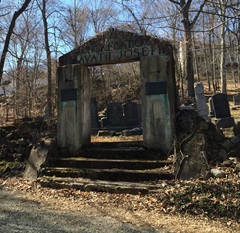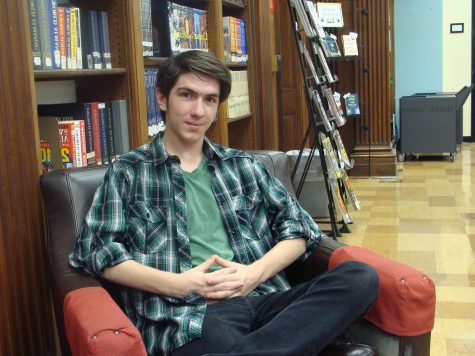Lost Treasure of Hawthorne: Three Unknown Cemeteries

The Ahavath Joseph cemetery in Hawthorne
March 29, 2016
Hawthorne is a unique little town in North Jersey with lots of hidden treasures. For example, it’s a good bet that many of you have never seen the three cemeteries in town that give us a unique record of our history.
Ahavath Joseph
The Ahavath Joseph cemetery is located on Brockhuizen Lane (off Goffle Road, right by the high school). This is a Jewish cemetery that was originally purchased by a group of people from Slutska, Lithuania (an area that is in modern-day Belarus). The group moved to Paterson in the early 1900s and formed a congregation called Ahavath Joseph on Godwin Street and used a plot of land in Hawthorne as their cemetery. The site is entered through an ancient-looking arch with a surrounding stone wall about three-feet high that gives the cemetery a sense of security. The cemetery is old and crumbling, but it is still cared for and the grave planting make a nice ground cover throughout the area. The grave stones range in height and length and some cover several plots; for instance, the Cohen headstone hovers above a couple graves. Some stones have fallen over the years and some are missing completely, but those that remain upright show that many deaths occurred around 1918 during the influenza epidemic. The cemetery is no longer used (the last to be buried there was in the 1990s), but the plot of land remains for Hawthornites to visit and learn from.
The Holland Cemetery (a.k.a. Vermulen Cemetery)
Right next to the Ahavath Joseph cemetery on Brockhuizen Lane is another cemetery that is easy to overlook in the wooded area because it has no entrance or borders and most of its headstones have fallen into the leaves and foliage. At the time of Hawthorne’s birth most of the settlers were of Dutch origin and descent. According to the Hawthorne Historical Society, this cemetery used in the 1800s by local Dutch churches. Today, the cemetery is abandoned. Very few graves remain and most of the bodies were exhumed and sent to the Fair Lawn cemetery. Exploring the remaining grave stones, you can see one that is for a child who died at age one and other stones that are written in Dutch. The headstone of Meindert Prol. reads, “There remains a rest for the people of God. Remembrance of Meindert Prol. Elder of the first Holland Church in Paterson NJ. Deceased on 21. Jan. 1889. In the Age of 62 years. 4 months. 22 days. In silent tomb nobody sings praises the Lord’s soul plunged without lye in the dust can not him Glory. But our tongue sing for in harmony in uniformity. …Praise God the source… life.” The translation is rough due to the dialect. There is much to explore in this section of the woods. Some say there is an old German cemetery near this one, and as you enter from the road, you’ll see six little stone spires that stick out of the ground in a rectangular format; this is suspected to be an enclosed area for someone of great importance.
DeGray-Ryerson Cemetery
This cemetery is also suspected to be the oldest one in Hawthorne. Located off Thomas Lane S (off Wagaraw Road), the cemetery is near the popular Veterans Field, but goes unnoticed by many. The cemetery dates back to at least the early 1800s. There is little information about the history of this cemetery and the graves are in rough condition—they are shattered, illegible and some are merely stubs, but they are there if you look for them. It is rumored that during rainfalls when the Passaic River would rise, it would lift up the coffins and corpses. The only grave that was barely legible had the date of death 1829 on it.
It is likely that the cemetery was once owned by Johannes Ryerson, one of the first settlers in Hawthorne who was born in the 1690s and died in the late 1770s or early 1780s. (He is believed to have owned a majority of Hawthorne.) There is a monument on Goffle Road that signifies this with a plaque and the few remaining stones of his estate. It is possible that he was buried at this cemetery or perhaps the Holland cemetery. Like the Holland cemetery, most bodies have been exhumed and moved elsewhere so it is questionable if any bodies still exist there.
The cemeteries are a great place to look into Hawthorne’s timeline to see what occurred. Graves can indicate large spread viruses that wiped out many, or the amount of children that died young. If going to the grave sites, please be respectful of the dead and let them rest in peace.

